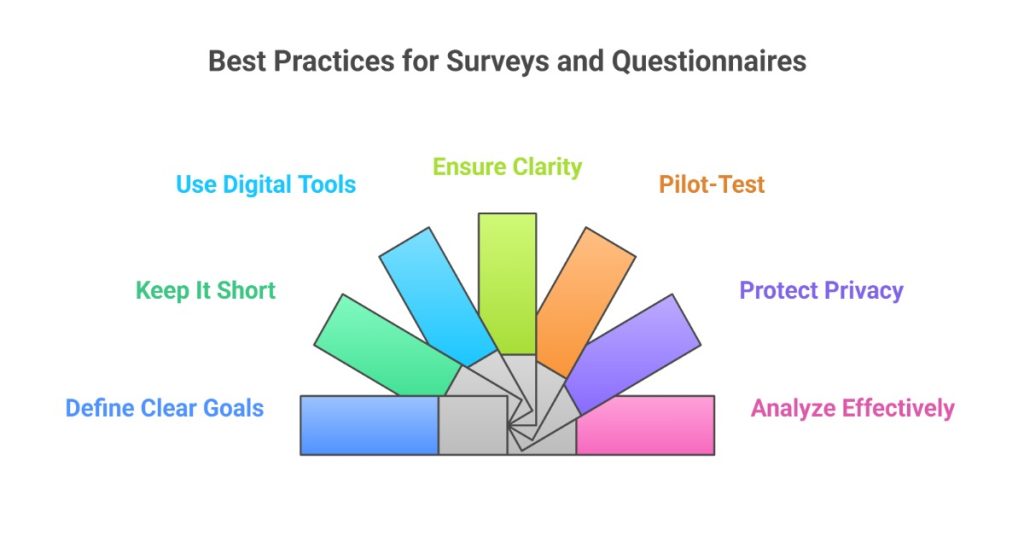In the world of data collection, survey vs questionnaire is a debate as old as chai vs coffee—both are useful, but they serve different purposes. In 2025, with research and feedback driving decisions in India’s booming education, corporate, and market sectors, understanding the difference between survey and questionnaire is crucial. Whether you’re a student tackling a survey vs questionnaire in a research project, a marketer crafting feedback tools, or an HR pro curious about when to use survey vs questionnaire, knowing their distinctions can make your data collection as smooth as a monsoon breeze.
This blog breaks down the questionnaire vs survey definition, offers a survey vs questionnaire comparison, and provides survey vs questionnaire examples to clarify their roles. With stats, practical insights, and a dash of humor, we’ll answer what is a questionnaire and a survey and guide you on survey vs questionnaire in data collection. Let’s dive in and clear the fog!
Table of Contents
What Is a Questionnaire?
A questionnaire is a set of written questions designed to collect specific information from respondents. It’s the core tool of data collection, like the script of a Bollywood movie—structured and focused on gathering answers. Questionnaires can be delivered online, on paper, or via interviews, with formats like multiple-choice, open-ended, or Likert scales.
- Key Features:
- A standalone tool focused on questions.
- Can be used independently or as part of a survey.
- Often standardized for consistency.
- Example: A list of 10 multiple-choice questions asking customers about their shopping habits, delivered via Google Forms.
- Stat: 70% of Indian researchers use questionnaires as their primary data tool (Indian Journal of Research, 2024).
- Purpose: Collect targeted data on specific topics, like customer satisfaction or employee feedback.
Fun Fact: A questionnaire is like a recipe card—just the ingredients, ready for you to cook with!

What Is a Survey?
A survey is a broader research method that involves collecting, analyzing, and interpreting data, often using a questionnaire as its tool. It’s like the entire Bollywood movie—script (questionnaire), actors (respondents), and direction (analysis). Surveys encompass the process of designing, distributing, and drawing conclusions from data.
- Key Features:
- A process that includes questionnaires, interviews, or other methods.
- Focuses on gathering and analyzing data to answer research questions.
- Often involves larger samples and statistical analysis.
- Example: A market research survey in Mumbai using a questionnaire to collect customer preferences, followed by data analysis to guide product launches.
- Stat: 65% of Indian businesses use surveys for market insights (FICCI, 2024).
- Purpose: Gain comprehensive insights into trends, behaviors, or opinions.
Fun Fact: A survey is like a full-on concert—questionnaires are the lyrics, but the performance brings it to life!
Survey vs Questionnaire: Key Differences
The difference between survey and questionnaire is like comparing a book to its chapters—one is the tool, the other is the whole story. Here’s a survey vs questionnaire comparison table to clarify:
| Aspect | Questionnaire | Survey |
| Definition | A set of questions to collect data. | A research method using tools like questionnaires to gather and analyze data. |
| Scope | Narrow—focuses on question design and responses. | Broad—includes design, collection, and analysis. |
| Purpose | Gather specific responses. | Understand trends, patterns, or insights. |
| Components | Questions only (e.g., MCQs, open-ended). | Questionnaires, sampling, analysis, and interpretation. |
| Example | A 10-question form on customer satisfaction. | A study using a questionnaire to analyze customer trends across India. |
| Use in Research | A tool within a survey or standalone. | The entire research process, often including questionnaires. |
| Time | Quick to create and distribute. | Longer, including analysis (e.g., 50% more time, per ResearchGate, 2024). |
| Output | Raw responses (e.g., “80% satisfied”). | Interpreted insights (e.g., “Satisfaction drives loyalty”). |
Pro Tip: Think of a questionnaire as the paintbrush and a survey as the finished painting.
Survey vs Questionnaire Examples
To nail the survey vs questionnaire example distinction, here are real-world scenarios showing how they work in survey vs questionnaire in research:
- Questionnaire Example (Education):
- What: A 15-question Google Forms questionnaire asking students, “Rate your online learning experience (1-5).”
- Context: Used by a Delhi school to collect raw feedback.
- Outcome: 75% of students rated the experience 4/5.
- Why It’s a Questionnaire: Focuses on collecting responses, not analyzing trends.
- Survey Example (Market Research):
- What: A Mumbai retailer sends a 10-question questionnaire via SurveyMonkey, then analyzes responses to identify shopping trends.
- Context: The survey includes sampling 2,000 customers and interpreting data to adjust inventory.
- Outcome: Found 70% prefer online shopping, leading to a new e-commerce strategy.
- Why It’s a Survey: Encompasses questionnaire design, data collection, and analysis.
- Questionnaire Example (Corporate):
- What: A 5-question form asking employees, “What improves your workplace satisfaction?” (open-ended).
- Context: Used by a Bengaluru IT firm to gather feedback for HR.
- Outcome: Collected 500 responses for further review.
- Why It’s a Questionnaire: Only the question set, no analysis yet.
- Survey Example (Sociology):
- What: A 2025 Rajasthan study uses a questionnaire on women’s rights awareness, samples 1,000 respondents, and analyzes data to inform policy.
- Context: Includes questionnaire design, distribution via WhatsApp, and statistical analysis.
- Outcome: 60% awareness, prompting new campaigns.
- Why It’s a Survey: Covers the entire research process.
Fun Fact: A questionnaire is like the script for a survey’s blockbuster research movie!

When to Use Survey vs Questionnaire
Choosing when to use survey vs questionnaire depends on your goals, resources, and scope. Here’s a guide for survey vs questionnaire in data collection:
When to Use a Questionnaire
- You Need Quick, Specific Data: Use for targeted feedback without deep analysis (e.g., customer ratings).
- Limited Resources: Questionnaires are faster and cheaper to create (e.g., 60% less cost, per SurveyMonkey, 2024).
- Standalone Tool: Ideal when you only need raw responses for later use.
- Example: A Chennai school uses a Google Forms questionnaire to collect parent feedback on facilities.
- Best for: Small-scale studies, initial data collection, or one-off feedback.
When to Use a Survey
- You Want Comprehensive Insights: Use for full research, including analysis and interpretation (e.g., market trends).
- Large Samples: Surveys handle bigger populations and statistical analysis (e.g., 65% of Indian surveys target 1,000+ respondents, FICCI, 2024).
- Complex Questions: Ideal for answering “why” or “how” through data synthesis.
- Example: A Pune startup surveys 2,000 customers to analyze product preferences and adjust marketing.
- Best for: Research projects, policy studies, or strategic business decisions.
Pro Tip: Start with a questionnaire for quick data, then expand to a survey for deeper insights if needed.
Advantages and Disadvantages of Surveys and Questionnaires
To round out the questionnaire vs survey differences, let’s compare their pros and cons:
Questionnaire
- Advantages:
- Quick to design and distribute (e.g., 15-minute setup with Google Forms).
- Cost-effective, especially with free tools.
- Flexible for standalone use or as part of surveys.
- Disadvantages:
- Limited to raw data, no analysis included.
- May miss broader context or trends.
- Stat: 70% of Indian researchers use questionnaires for quick feedback (EdTech India, 2024).
Survey
- Advantages:
- Comprehensive, covering design, collection, and analysis.
- Ideal for large-scale, statistically robust insights.
- Provides actionable conclusions (e.g., 80% of surveys drive business decisions, FICCI, 2024).
- Disadvantages:
- Time-consuming and resource-intensive (e.g., 50% more effort, ResearchGate, 2024).
- Requires analytical skills or software like SPSS.
- Stat: Surveys take 2-3x longer than questionnaires but yield 30% richer insights (Indian Journal of Research, 2024).
Fun Fact: A questionnaire is like a single song; a survey is the whole album!
Best Practices for Surveys and Questionnaires
To maximize survey vs questionnaire in data collection, follow these tips:
- Define Clear Goals: Questionnaires for specific data; surveys for broader insights.
- Keep It Short: Limit questionnaires to 10-15 questions to avoid fatigue (25% higher completion rates, SurveyMonkey, 2024).
- Use Digital Tools: Platforms like Google Forms or Typeform streamline creation (used by 65% of researchers, EdTech India, 2024).
- Ensure Clarity: Avoid jargon or leading questions (e.g., “How satisfied are you?” not “Isn’t this great?”).
- Pilot-Test: Test with a small group to catch errors (fixes 80% of issues, ResearchGate, 2024).
- Protect Privacy: Comply with India’s DPDP Act 2023 for data security.
- Analyze Effectively: Use Excel or SPSS for surveys to turn data into insights.
Real Example: A 2025 Hyderabad survey used a Typeform questionnaire with 12 questions, achieving a 90% response rate and actionable marketing insights.

Common Misconceptions
Let’s bust some myths about survey vs questionnaire:
- Myth: “A questionnaire is always a survey.”
Truth: A questionnaire is a tool; a survey is the process that may use it. - Myth: “Surveys are better than questionnaires.”
Truth: Depends on the goal—questionnaires are great for quick data, surveys for in-depth analysis. - Myth: “Questionnaires are outdated.”
Truth: Digital questionnaires are booming, with 70% online in 2025 (EdTech Review, 2024).
Frequently Asked Questions
Q: What’s the main difference between a survey and a questionnaire?
A: A survey is a broader research method, while a questionnaire is a specific tool used to collect data.
Q: When should I use a survey?
A: Use a survey when you need to gather information about a specific topic or issue, understand customer opinions, or identify market trends.
Q: When should I use a questionnaire?
A: Use a questionnaire when you need to collect specific, detailed information about respondents’ attitudes or experiences, or gather data for research studies or evaluations.
Q: How can I create an effective survey or questionnaire?
A: Keep it concise, use clear language, pilot-test, and use multiple channels to distribute your survey or questionnaire.
Wrapping It Up
The survey vs questionnaire debate boils down to scope: a questionnaire is the tool, a survey is the journey. Understanding the difference between survey and questionnaire helps you choose the right approach for your research, whether it’s a quick questionnaire vs survey definition for feedback or a full survey vs questionnaire in research for deep insights. With survey vs questionnaire examples and best practices, you’re ready to collect data like a pro in 2025.
Ready to craft your next questionnaire or survey? Use Google Forms for a quick questionnaire or SurveyMonkey for a full survey, and follow our tips for success. Got a survey vs questionnaire comparison story or a data collection tip? Drop it in the comments or share this blog for a when to use survey vs questionnaire masterclass vibe. Here’s to making data collection in 2025 as seamless as a viral Instagram reel!
Read More
Data Collection Methods: A Complete Guide to Qualitative, Quantitative & Mixed Techniques
Top 10 Advantages of Online Surveys: Cost, Speed & High Response Rates
A Guide to Different Types of Questionnaires for Research

